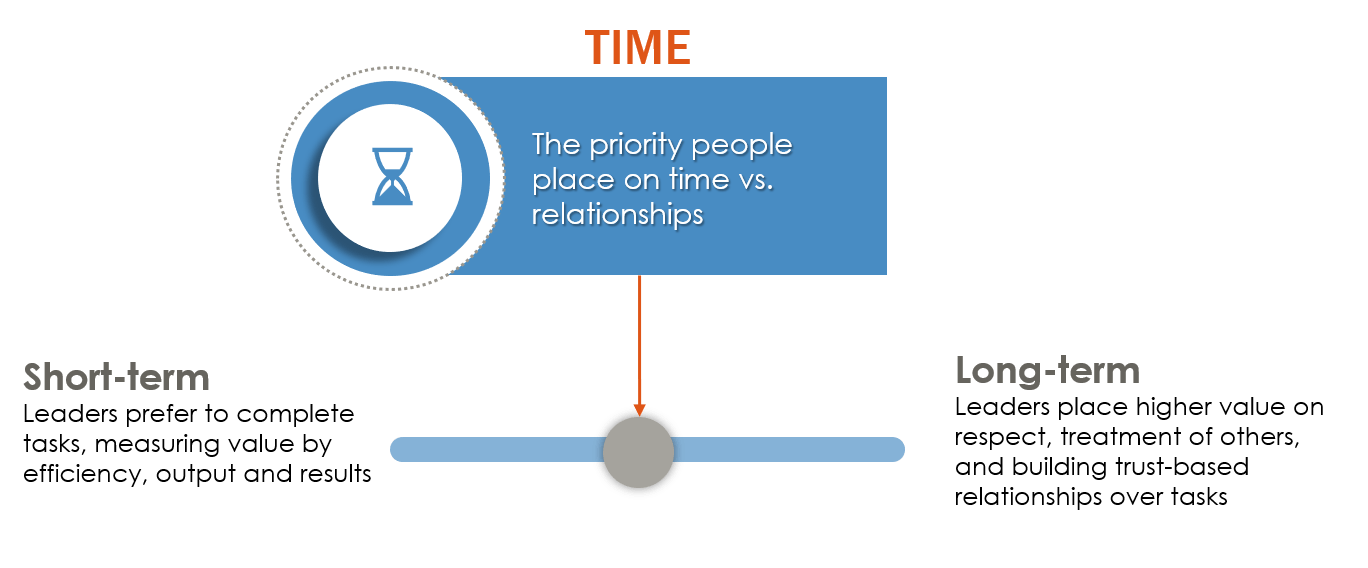In the context of organizational culture, “time” is defined as the priority people place on time vs. relationships, and in our experience, organizations that “get it right” more often than not enjoy greater success. Many clients over the years have challenged us as to whether they need to choose between the two ends of this dimension. “No, you don’t.” But you do need to know when to play each end of the culture dimension of time to get the best results.
It’s not just the volume or output (i.e., perceived performance) that drives our behavior; it can also be our approach to task completion. In traditional, industrial manufacturing environments, employees are more wired to see their work in a linear fashion, i.e., “assembly-line mentality,” “my job goes from here to here, nothing more, nothing less.”
I recall a great story from a client in Mexico City when I was just getting into the field of cross-cultural training and consulting. It went something like this:
“I hosted a vendor the other day from Los Angeles. He came in that morning, how do you say, ‘guns a blazing,’ all set to sell me the next shipment of goods we often used in our manufacturing process. He greeted me in his classic manner, overly firm handshake, big personality, loud voice, ready for action. I decided to play a trick on him.
I picked him up at the airport, brought him to a nice hotel where many of our visitors stay, near our famous Plaza de la Constitución (aka zócalo), assured him that he must be tired, and told him I would pick him up for an early dinner at 7:00 p.m. Without hesitation, he reacted, ‘No, no, that is not possible, I have a flight back to LAX at 7 p.m. tonight; I’m just here for the day.’
I knew he was all business from my previous encounters with him, but this took it to a whole new level. I suggested we sit, have some coffee, and I was sure everything would work out okay. He went on and asked me, ‘How do you all get anything done here; how do you make any money, if all you are doing is having coffee and delaying getting down to business?’
He continued. ‘Don’t you see, if you all worked harder, if you pushed the manufacturing process further, if you spent more time building up your business, building more plants, producing more product, selling more product, you could retire early, and have plenty of time to do whatever you want, like drinking coffee.’ He paused, realizing his last sentence. I barely needed to comment, but I took the chance to close the circle. I simply shared, ‘Like we are doing right now, my friend?’”
Obviously, we can’t all sit back, sip coffee, and fill every day in this calm manner. But it does point out the importance of balance, some call work/life harmony. Many organizations would benefit from slowing down a bit, considering the value of what they are creating, and reducing the pace and pressure leaders place on themselves and their employees.
As a colleague once shared with me when I was being particularly high-strung: “Time is time; and money is money.” Some of the most impressive organizational cultures with incredible results, are often the ones that are measured in their pace of work. They are strategic, thoughtful, planful, and thorough. They engage their employees deeply, and they see time from a long-term perspective. They are willing to delay short-term gratification for long-term gain.
For more information on The Secret 7, or if you would like to receive a unique survey link (custom URL), free for your company/ organization, please
click here
and complete the form.













